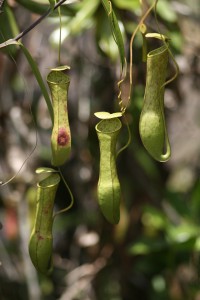The pitcher plant, the beetle, and relying on rain for your next meal

 It’s a trap!
It’s a trap!
In the fields of Brunei Darussalam in North Borneo, once a crown colony of Great Britain, lies the pitcher plant. The pitcher plant is carnivorous, capturing and devouring insects that seek to harvest its nectar.
The pitcher plant is beguiling, attractive, and has evolved many ways to seduce its predator. Insect prey is captured within the wells of its pitcher-shaped leaves, when insects crawling along it slip on the wax crystals of the inner wall, and fall into the digestive fluids at the bottom. A dense layer of platelet-shaped wax crystals, orientated perpendicularly to the surface for a reason — to essentially make it difficult for insects to grip — especially when wet.
The wax crystal layer is a common feature to many species of the pitcher plant. One such species, Nepenthes gracilis, is unusual in the fact that the crystals are also present on the underside of the pitcher lid.
This was the observation that led to recently published research describing a new way the pitcher plant captures its prey.
The lead author of the paper, published today in PLoS ONE, Dr Ulrike Bauer from the University of Cambridge’s Department of Plant Sciences, said: “It all started with the observation of a beetle seeking shelter under a N. gracilis lid during a tropical rainstorm. Instead of finding a safe — and dry — place to rest, the beetle ended up in the pitcher fluid, captured by the plant. We had observed ants crawling under the lid without difficulty many times before, so we assumed that the rain played a role, maybe causing the lid to vibrate and ‘catapulting’ the beetle into the trap, similar to the springboard at a swimming pool.”
In effect, it’s a clever strategy on the part of the pitcher plant. At times, mostly when the weather is dry, insects have no problem gathering nectar from the plant. This allows “scout
 Follow
Follow
1 thought on “The pitcher plant, the beetle, and relying on rain for your next meal”
Comments are closed.